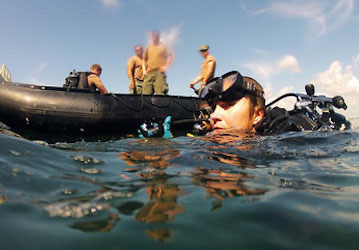A shallow water blackout happens when you lose consciousness while swimming and diving in water less than about 15 feet deep. It can also happen at deeper depths when you black out due to hyperventilation before a dive. Hyperventilation increases the amount of oxygen and decreases the amount of carbon dioxide in your blood stream. There is little scientific evidence that it can help you hold your breath longer, and it is extremely dangerous.
Causes of shallow water blackout
Shallow water blackout (SWB) is what is called a “rare but serious” event. There are only a handful of documented SWB events each year, but they often result in death. It is more common in elite or highly motivated swimmers, usually training for an event. In 2016, a Navy BUD/S candidate died during swim training after suffering a shallow water blackout. Other military cases involve Military Service Members preparing to enter rigorous training, such as SOF assessment and selection courses.
SWB often happens when you hold your breath repeatedly for long periods with little rest in between reps. Examples include repeated underwater laps, or bobbing under the surface several times, which can cause hyperventilation. Long, repeated bouts of breath holding do not allow your body enough time to recover and reset oxygen levels in your blood. Give your body enough time to catch your breath in between sets when swimming laps.
Breath-holding training is one of the most common events where SWB occurs. It is an important skill, not only for divers, but also for Military Service Members who might have to be in the water, such as aircrews during emergency egress training after ditching in the water. Breath-holding exercises should only be performed during official training evolutions and under extremely close supervision.
Hyperventilation
Hyperventilation is when you take short, fast breaths. It can be involuntary, often caused by anxiety or panic attacks, or done intentionally. During normal breathing, you breathe in oxygen. Between breaths, your body takes the oxygen out of your blood, and replaces it with carbon dioxide (CO2). When you breathe out, you expel the carbon dioxide and the process repeats. As carbon dioxide builds in your blood—between breaths and when you’re intentionally holding your breath—it sends a signal to your brain that it’s time to breathe. The urge to breathe is driven by a buildup of CO2 in your system.
When you hyperventilate, you don’t give your body enough time to exchange oxygen for CO2 in your blood. This causes oxygen levels to stay level and CO2 levels to fall. As you do this, you start to just push air in and out of your lungs. This removes the chemical (CO2) that makes you feel the need to breathe without significantly increasing the amount of oxygen in your blood stream.
There is little scientific evidence that hyperventilating can improve your ability to hold your breath longer.
As you hold your breath after hyperventilating, your body uses the oxygen in your blood and replaces it with carbon dioxide. However, because you have forced out so much CO2, you never reach the level that tells your brain it’s time to breath. You will eventually faint, which allows your body to reset and start breathing normally. If you do this underwater, you immediately inhale water directly into your lungs. Drowning happens almost instantly, unless somebody pulls you out of the water as soon as you lose consciousness. Even if a lifeguard is watching, the seconds it takes to get out of the chair and into the water is too long.
The appearance of SWB
When people suffer shallow water blackout, there is no panic or sense of urgency to breathe. Videos of swimmers experiencing SWB show them transition from active swimming to an unconscious float or glide through the water. It can be hard to spot if you are not watching closely, which is what makes it so dangerous.
Preventing shallow water blackout
- Never hyperventilate before swimming or diving.
- Swim with a buddy who is closely supervising you and not working out at the same time. If it isn’t during an official training evolution, don’t rely on a lifeguard to spot your SWB.
- Give your body enough time to recover and catch your breath between sets. This will allow oxygen levels to return to normal.
